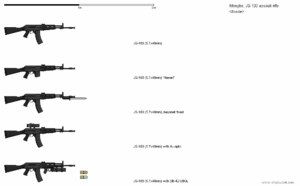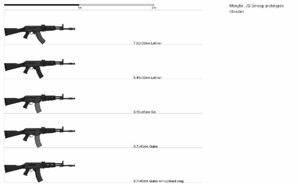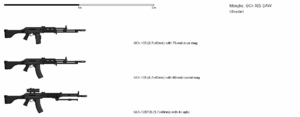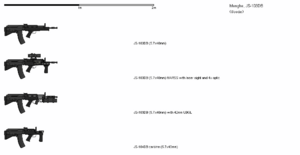JS-103
| Type 103 Automatic Rifle (JS-103) | |
|---|---|
 Common configurations of the baseline JS-103 | |
| Type | assault rifle |
| Place of origin | |
| Service history | |
| In service | 2004 to present |
| Used by | see "Users" |
| Production history | |
| Designer | Hwasŏng Arsenal 55 |
| Designed | 1996-2003 |
| Manufacturer | Chowonsuri 2nd Machine Plant, Taekchŏn |
| Produced | 2003 - Present |
| Variants | see below |
| Specifications (JS-103 standard model) | |
| Weight | 3.5 kg without magazine 3.9 kg with 30rnd magazine |
| Length | 945 mm (stock extended) 698mm (stock folded) |
| Barrel length | 467 mm |
| Width | 68 mm |
| Cartridge | 5.7x40mm |
| Action | Gas operated, rotating bolt |
| Rate of fire | 650 rpm |
| Muzzle velocity | 900 m/s |
| Effective firing range | 500 m |
| Maximum firing range | 800 m (area target) |
| Feed system | 10, 30, or 45-round detachable box magazine or 100-round drum magazine |
| Sights | Adjustable iron sights Side rail for attaching optics |
The JS-103 (Formal designation: 103식 자동 소총 / 一〇三式自動小銃, Il-ryŏng-sam-sik jadong sochong, "Type 103 automatic rifle;" Short designation 103식, Illyŏngsam-sik, "Type 103") is a gas-operated, selective fire assault rifle developed in Menghe to replace the earlier JS-67. Unlike its predecessor, which was chambered in 7.62x39mm ammunition, it fires a smaller and lighter intermediate round. It has replaced the JS-67 and JS-93 in all active-service units of the Menghean Army, though most reservist units still use the older weapons.
Development
Policy discussions about the procurement of a new assault rifle were already underway in the mid-1990s, but it was only around the turn of the century that the Menghean Army expressed serious interest in the idea. Much of the debate stemmed from conservative-minded officers' concern that lighter cartridges would lack the performance of the then-standard 7.62x39mm round, and that more modern service weapons would lack the reliability of the JS-67 and JS-93.
Combat experience in the Polvokian Civil War finally pushed the Menghean Army to express serious interest in a new service rifle, which would itself be lighter while carrying lighter ammunition. Launched in 2000, the "JS-Sinsegi" (Assault Rifle for the New Century" project called for a weapon with polymer furniture, a three-round burst setting, an optional under-barrel grenade launcher, an improved muzzle brake, and similarity to the JS-93 in layout and maintenance. The cartridge used by the weapon was left undecided, as the Army's own procurement staff had yet to settle their own disagreements about whether to transition to a lighter round.
Hwasŏng Arsenal 55, Menghe's leading small-arms producer, responded with two related sets of prototypes chambered in four possible calibers. The first used the same 7.62x39mm round as previous Menghean assault rifles, while the second used the Letnian 5.45×39mm cartridge, reputed for its good wounding effects. In light of the new regime's greater openness to Western powers, the next two prototypes used Western cartridges: 5.56×45mm and 5.7mm Quinn. These prototypes differed in using a straight-insert magazine well, in contrast to the "rock-and-lock" magazine well of the Letnian-patterned and indigenous weapons. They also had milled lower receivers with revised magazine wells, as well as different trigger mechanisms which included three-round-burst capability.
Trials took place throughout 2001 and 2002, though Army evaluators were slow to reach a conclusion. The 5.45mm Letnian round was eliminated due to its poor anti-armor performance, and the 7.62x39mm prototype proved noticeably heavier than its competitors, especially when adding the weight of an 8-magazine combat loadout. Consistent with Galenic testing, the 5.7x40mm round performed noticeably better than the other two intermediate cartridges at long ranges, and exhibited better accuracy than the 7.62x39mm precursor. On the other hand, "old cadre" Army officers viewed the milled lower receivers of the Western-magazine versions as inefficient with regard to weight and production time, noting that they added nearly half a kilogram onto empty weight. Additional debate centered on whether the weapon should have three-round burst capability: combat experience in the Polvokian Civil War suggested that accurate burst fire at long range was valuable in low-intensity combat, but old cadre conservatives saw the new trigger group as unnecessarily complex, and preferred to stick with existing Menghean infantry tactics, which favored close-range assaults using automatic fire. Handling trials also revealed problems with STANAG magazines failing to latch properly when inserted, taking longer to switch, and failing to feed properly after very rough handling, though these issues were likely a result of unfamiliarity on the part of conscript testers rather than inferiority on the part of the weapon itself.
As a response to problems with the 5.7 magazines, Hwasŏng drew up a hybrid fifth prototype. It featured a custom-built Menghean magazine which loaded 5.7mm cartridges but used an AN-style lock and release notch on the back rim. The new stamped steel magazines also stood up to rough usage better and were much less likely to suffer feeding problems, at the cost of being heavier. Just as importantly for the procurement conservatives, they could feed into a stamped lower receiver with no burst-fire mechanism. In June of 2003, the Menghean Army finally adopted this modified fifth prototype as the "Type 103 Automatic Short Rifle," or JS-103 in Anglian-language promotional literature, and ordered it into limited production.
Design (JS-103)
Layout
The JS-103 has some resemblance to the original JS-67, and it shares the same general internal layout, allowing soldiers trained in one weapon to easily learn how to disassemble and maintain the other. Both use a long-stroke gas piston running above the barrel, and all controls except the safety lever are identically placed. Disassembly is also identical: the user depresses the catch above the buttstock, removes the dust cover, and pulls the bolt carrier assembly out the top of the weapon. These similarities allow a soldier trained in one weapon to easily transition to the other.
Externally, the most visible difference between the JS-103 and its precursors is the use of black polymer furniture rather than wood, a measure intended to save weight. The metal parts were also given a protective coating to reduce wear. More subtle differences include the absence of a large safety lever on the right-hand side, the placement of the front iron sight on top of the vertical gas block, and the use of a birdcage flash suppressor rather than a ribbed rifle grenade adaptor on the barrel. Variants chambered for the 5.7×40mm round also have a magazine with a distinctly less pronounced curve.
Barrel
Although earlier prototypes included a large muzzle brake with two openings per side, the final JS-103 design used a smaller muzzle brake to reduce the effect of gas deflection to soldiers on either side. This muzzle brake has screw threads to permit the installation of a blank-firing adaptor but in its standard variant it cannot accept suppressors, extra muzzle brakes, or other end-of-barrel attachments. The weapon is unable to fire rifle-grenades, and no rifle grenades for the weapon have been put into service. Instead, the JS-103 relies on under-barrel lugs to allow the mounting of a separate YB-42 42mm grenade launcher. This is aimed using a fold-out sighting bar with angle increments for different ranges.
The JS-103 also has under-barrel mountings for a new type of bayonet, which is shorter and sturdier than the "sword" bayonet used for the JS-67. This bayonet incorporates a rear hook which can be used as a simple can-and-bottle opener or a wire cutter, when paired with the steel edge of the sheath. It is not reverse-compatible with the bayonet mounting on the JS-67, nor can the JS-67’s bayonet be mounted on the JS-103.
Optics and customization
As the JS-103 was designed before Menghe's adoption of the Modular Accessory Rail System in 2011, it lacks any provisions for MARS or MASS rails in its base variant. Instead, it has a single dovetail rail on the left side of the receiver, identical to the one on the JS-93. This can be used to mount a variety of sights on specialized mounts reaching over the receiver side; 4x optics are most common, though most Menghean riflemen still use the basic iron sights, which are similar to those on the JS-67 and can be adjusted out to a range of 900 meters.
Since 2011, the Menghean Army has approved a number of customization kits for the JS-103 to incorporate MARS rails for greater customizability. Because the upper receiver is a loose-fitting dust cover piece held in place by spring tension, it cannot be used as a basis for MARS rail mountings, and MARS rail frames reaching over the receiver from the dovetail rail must be removed prior to disassembly of the weapon. Handguards with MASS slots have been implemented more successfully.
Ammunition
The JS-103 is chambered in the Glasic 5.7mm Quinn cartridge, selected due to its good performance at long ranges. Its effective range against a man-size target is usually listed as 500 meters but may be closer to 300 in practice for a conscript soldier using iron sights. With a 4x optic, this range can be extended out to 600 to 700 meters. Conscripts are also trained to deliver suppressing fire on indirect targets to ranges of out to 800 meters, without the use of an optic. In fully automatic mode, the JS-103 has a cyclic rate of fire of about 600-700 rounds per minute. Combat exercises determined that the "effective" rate of fire in combat is closer to 100 rounds per minute, when accounting for reloading.
The JS-103 feeds from curved steel magazines with a rockback locking and release system. Manufactured like the magazines for the JS-67, these are known for being rugged and durable, with a very secure fit in the weapon. In its assault rifle variant, the JS-103 is generally issued 30-round double-stack magazines, but there are also 10-round magazines for the Internal Security Forces, 60-round quad-stack magazines, and 75- and 100-round drum magazines, the latter three all for the GCh-105.
JS-103 magazines produced after 2007 have a rudimentary bolt-hold-open system: the follower has a flat, sturdy rear side, which catches the advancing bolt on an empty magazine and props it open. This provides a visual cue to the user that the magazine is empty, and by holding open the bolt carrier, allows the user to check that the chamber is empty. When the empty magazine is removed, the bolt carrier immediately drops forward, and must be re-cocked when a fresh magazine is loaded.
Variants
JjS-104
The JjS-104 (104식 짧은 소총, Il-yŏng-sam-sik jjalbŭn sochong, "Type 103 short rifle") is a carbine variant of the JS-103, with a shortened barrel and a lighter stock. Otherwise, it uses the same receiver as the full-size weapon. Because the barrel is shorter, the weapon has a lower muzzle velocity and greater dispersion, reducing the effective range to 400 meters. It is also unable to mount the standard 42mm grenade launcher. In Menghean Army service, the JjS-103 is generally issued to the crews of armored vehicles, who may have to store the weapon in a confined space and quickly carry it out of a hatch when exiting the vehicle. It is 713 mm long with its stock extended, 518 mm long with its stock folded to the left, and weighs 2.7 kilograms without a magazine.
GCh-105
The third partner in the original JS-103 triad, the GCh-105 (105식 기관총, Il-yŏng-sam-sik gigwanchong, "Type 105 machine gun") is a light machine gun built in the same style as the GCh-67 before it. It has a longer, heavier chrome-plated barrel, which increases accuracy in automatic fire at range. The new barrel is also more resistant to overheating, but lacks a quick-change mechanism, reducing the sustained rate of fire compared to a dedicated light machine gun. The Menghean Army deemed these sacrifices worthwhile, as the weapon is mainly intended for small Mechanized Infantry squads which have fewer footsoldiers than APC-borne units and can usually rely on the firepower of their IFV.
Save for a few modifications to the return mechanism and recoil spring, the GCh-105 uses the same receiver parts as the JS-103, aiding in training and maintenance. It can also be recognized for its "club-foot" stock and always carries a bipod. The standard-issue GCh-105 is 1.084 meters long with stock extended and weighs 5.03 kilograms empty.
When the GCh-105 was first introduced, the Menghean Army issued it with 75-round drum magazines, though it is also compatible with the standard 30-round magazines issued to other squad members. Field trials and exercises soon revealed problems with the drum magazines, which were known to jam and break easily. Soldiers also complained that the large drums were too bulky when carried in webbing. The Army responded by developing a 60-round, quad-stack casket magazine. This is similar in external dimensions to the 30-round double stack magazine for the JS-103, albeit twice as thick at the base, and after receiving much better reviews from soldiers it has been phased in as the new standard option.
GCh-105PCh
In 2011 Hwasŏng Arsenal 55 unveiled a new variant of the GG-103, designated the GCh-105PCh. Like the JS-103PCh described below, it incorporates a balanced recoil system (BARS), and also widens the gas port and shifts it further back. In combination with the heavy barrel and bipod, this allows for greater accuracy during sustained automatic fire. Army officials initially delayed procurement due to concern that this change would reduce the size of the beaten zone, trading away area-suppression capability for precise fire on individual targets. Nevertheless, after 2015 the Army ordered the GCh-105PCh into large-scale production, apparently with the aim of fully replacing the GCh-105 in Class 4 units.
JS-103PCh
Although it was not part of the original design requirement, Hwasŏng developed an experimental variant of the JS-103 with a balanced recoil system extending forward over the barrel. The suffix PCh stands for Pyŏnghyŏngchu, or "counterweight," a reference to this recoil balancing feature.
Due to its lengthened barrel and revised muzzle brake, also intended to improve accuracy, the weapon is six centimeters longer than the basic JS-103 and 800 grams heavier. Early trials conducted by Hwasŏng in 2005 claimed that the weapon "virtually eliminated recoil and muzzle climb, allowing highly accurate automatic and burst fire," but fed suspicion in the procurement agency that the manufacturer was exaggerating the weapon's capabilities in order to win sales. The remaining members of the old establishment also expressed concern that the added moving parts could make the weapon more prone to jamming, a fear which later proved unsubstantiated.
In 2007, the Army ordered a batch of JS-103PCh rifles for Gunchal rear-area patrol units, but did not place any additional orders for several years. A state news agency, quoting mid-level Army news bureaus, suggested that the program had been killed, but in 2012 the Army's Airborne Assault Forces placed large orders for new JS-103PChs with the aim of replacing the JS-103 in all of its combat units. The Marine Infantry followed suit in 2014.
At an October 2016 news conference, however, the Procurement Board of the Menghean Army confirmed that it would place orders for regular Army units "beginning in 2017." This announcement, along with leaked documents about the status of the BSCh-12 IFV program, led to speculation in defense circles that the implementation date for the Class 5 Army Reorganization had been moved ahead from 2025 to 2020.
JS-103DB
Unveiled at a 2008 arms show, the JS-103DB is an independent design project developed by Hwasŏng in the absence of an Army requirement. It consists of a JS-103 rebuilt in a bullpup configuration, using the original barrel, piston, and receiver with reconfigured furniture. The trigger is connected to the firing sear by a flat steel rod running inside the lower receiver, and the safety is not duplicated. An even shorter JjS-104DB carbine using the barrel of the JjS-104 and a special foregrip was unveiled in 2010.
The Menghean Army has shown no interest in either weapon, citing the poor ergonomics of the converted JS-103 receiver and the tendency of the trigger-to-sear connection to flex as the weapon heats up. The JS-103DB received more interest from foreign customers, including Idacua, which purchased 1000 examples for its special forces in 2012. JjS-104DB carbines have also been spotted in the Rapid Response Brigades and counterterrorism units. Work on both solutions also provided Hwasŏng with valuable experience in developing bullpup prototypes from the ground up, as part of the Army's requirement for a JS-103 replacement.
Full list of variants
- JS-103: Standard assault rifle variant used by the Menghean Army.
- JS-103 Naean: Special variant for the Internal Security Forces. It is only capable of semi-automatic fire. It is generally issued 10-round magazines, but is capable of accepting 30-round magazines.
- JjS-104: Carbine variant.
- GCh-105: Light machine gun variant.
- TS-106: A dedicated variant for the special forces, based on the JjS-104 but with a built-in suppressor. It has been seen with both 20-round and 30-round magazines.
- JS-107: Variant of the JS-103 with recoil balancing system.
- GCh-115: Variant of the GCh-105 with recoil balancing system.
- JS-103L: Export variant chambered in 7.62x39mm. Capable of accepting AN-47 magazines.
- JjS-104L: JjS-104 chambered in 7.62x39mm.
- GCh-105L: GCh-105 chambered in 7.62x39mm.
- JS-103G: Export variant chambered in 5.56x45mm, using the milled lower receiver and a 3-round burst mechanism. Capable of accepting STANAG magazines.
- JjS-104G: JjS-104 chambered in 5.56x45mm.
- GCh-105G: GCh-105 chambered in 5.56x45mm.
- JS-103Yu: Export variant chambered in 5.45x39mm. Capable of accepting AN-74 magazines.
- JjS-104Yu: JjS-104 chambered in 5.45x39mm.
- GCh-105Yu: GCh-105 chambered in 5.45x39mm.
- JS-107G: 5.56x45mm export version of the JS-107, first showcased in 2011. Also features milled lower receiver with 3-round burst setting.
Planned replacement
While the JS-103 earned a favorable reputation in the Menghean Army, it came with a number of shortcomings that limited its future growth potential. The weapon's construction prohibited the mounting of MARS rails on the upper receiver, which was not firmly attached to the barrel forward or behind the rear iron sight and could lose zero easily. Special forces units, such as the Deep Mission Troops and airborne and marine infantry, were especially dissatisfied with the weapon's inability to accept different optics. The JS-103 was also uncomfortable to shoot left-handed, and while Menghean Army doctrine dictated that all recruits train in right-handed shooting, the inability to switch to left-side handling when shooting from cover was a situational liability.
In 2016, after reviewing combat reports filed after the Innominadan Crisis, the Menghean Ministry of National Defense issued a design requirement for a new assault rifle with the following characteristics:
- The upper receiver must be firmly mounted to the barrel, allowing a Type 111 rail (MARS rail) to be mounted along its full length.
- The safety, magazine release, and charging handle must be fully ambidextrous.
- The cartridge ejection system must allow for ambidextrous operation.
- The handguard (or lower handguard) must be replaceable so as to allow the mounting of a grenade launcher module or other handguard options.
- The barrel must be fixed to the trunnion so as to allow the installation of a different barrel with minimal tools.
- The standard buttstock must be replaceable so as to allow the mounting of different standard buttstocks.
- The weapon must be chambered in 5.7×40mm (5.7mm Quinn)
- The weapon must be compatible with standard-issue magazines for the JS-103; new magazines may be introduced but they must be reverse-compatible.
Beyond these requirements, the MoND stated that submissions "will be judged according to ergonomics, weight, accuracy, durability, and simplicity of manufacture."
Users
 Argentstan
Argentstan Dzhungestan
Dzhungestan Idacua: Adopted in 2004, with major deliveries from 2010 onward
Idacua: Adopted in 2004, with major deliveries from 2010 onward Republic of Innominada
Republic of Innominada Menghe
Menghe Qusayn
Qusayn- Template:Country data Ummayah
See also



